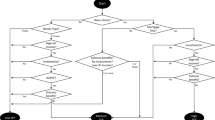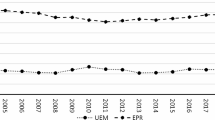Abstract
In the Western countries, including Belgium, life expectancy has increased over the last decades, as well as social inequalities in health and mortality. Existing research tends to approximate socioeconomic status with the educational level, occupational status or income. Housing is yet another socioeconomic factor that is much less considered when studying inequalities in mortality. Indeed, housing is a complex and multidimensional element impacting several aspects of a person’s health and well-being (physical, mental and social). The data used in this research are the result of the coupling of the population censuses of 1991, 2001 and 2011 and the National Register. They cover the entire population of Belgium over 25 years. Through life tables analysis and multivariate logistic regression models, this research contributes to existing research by setting trends in housing conditions between 1991 and 2016 in relation to social inequalities in health and mortality over this period in Belgium. It shows that housing conditions have a specific effect on the risk of death, in addition to other socio-economic characteristics. On the 2011–2015 period, once controlling for demographic and socioeconomic characteristics (education, professional status and income), a 25% higher mortality rate separates tenants from owners on the one hand, and population living in low quality housing from those living in better quality housing on the other hand. Ensuring good housing conditions seems a necessary step to reduce inequalities that should be considered in social policies.
Similar content being viewed by others
References
Bernard, Y. (1998). Du logement au chez-soi. In M. Segaud, C. Bonvalet, & J. Brun (Eds.), Logement et habitat: l’état des savoirs (p. 420). Paris: La découverte.
Bonnefoy, X. (2007). Inadequate housing and health: An overview. International Journal of Environment and Pollution, 30(3–4), 411–429.
Boomsma, C., Pahl, S., Jones, R. V., & Fuertes, A. (2017). Damp in bathroom. Damp in back room. It’s very depressing!” exploring the relationship between perceived housing problems, energy affordability concerns, and health and well-being in UK social housing. Energy Policy, 106, 382–393.
Bugeja-Bloch, F. (2013). Logement, la spirale des inégalités. Paris: Puf.
Chatelard, S., Vaucher, P., Wolff, H., et al. (2012). Le médecin face aux inégalités sociales de santé: quel pouvoir d'action? Revue médicale suisse, 341, 1061.
Coburn, D. (2004). Beyond the income inequality hypothesis: Class, neo-liberalism and health inequalities. Social Science & Medicine, 58, 41–56.
Coley, R. L., Leventhal, T., Lynch, A. D., & Kull, M. (2013). Relations between housing characteristics and the well-being of low-income children and adolescents. Developmental Psychology, 49(9), 1775.
Deboosere, P., & Fiszman, P. (2009). About persistent socio-spatial inequalities in health: The Belgian example. Space Populations Societies, 2009/1, 149–158.
Deboosere, P., Gadeyne, S., & Van Oyen, H. (2009). The 1991–2004 evolution in life expectancy by educational level in Belgium based on linked census and population register data. European Journal of Population/Revue européenne de Démographie, 25(2), 175.
De Keersmaecker, M.-L. (1997). Right to housing and inequalities. In: De Keersmaecker, M.-L. (dir.). Social inequalities in Belgium. Bruxelles : Vie Ouvrière. 200 p.
Dunn, J. (2002). Housing and inequalities in health: A study of socioeconomic dimensions of housing and self reported health from a survey of Vancouver residents. Journal of Epidemiology and Community Health, 56(9), 671–681.
Eggerickx, T., Sanderson, J.-P., & Vandeschrick, C. (2018). Social and spatial inequalities of mortality in Belgium: 1991–2016. Space Populations Societies, 2018-1, 27.
Emelianoff, C. (2008). The problematics of ecological inequalities, a new conceptual landscape. Écologie & Politique, (1), 19–31.
Evans, G. W., Wells, N. M., & Moch, A. (2003). Housing and mental health: A review of the evidence and a methodological and conceptual critique. Journal of Social Issues, 59(3), 475–500.
Gadeyne, S. (2006). The ultimate inequality: Socio-economic differences in all-cause and cause-specific mortality in Belgium in the first part of the 1990s. Centrum voor Bevolkings-en Gezinsstudie (CBGS).
Ghekière, L. (2008). The development of the social housing in European Union. Recherches Et Prévisions, 94(1), 21–34.
Herbert, C. E., & Belsky, E. S. (2008). The homeownership experience of low-income and minority households: A review and synthesis of the literature. Cityscape, 10, 5–59.
Herjean, P. (2006). A multilevel approach to health. Cahiers de géographie du Québec, 50(141), 347–355.
Hiscock, R., Kearns, A., Macintyre, S., & Ellaway, A. (2001). Ontological security and psycho-social benefits from the home: Qualitative evidence on issues of tenure. Housing, Theory and Society, 18(1–2), 50–66.
Hiscock, R., Macintyre, S., Kearns, A., & Ellaway, A. (2003). Residents and residence: Factors predicting the health disadvantage of social renters compared to owner-occupiers. Journal of Social Issues, 59(3), 527–546.
Jusot, F. (2010). Les interventions de réduction des inégalités sociales de santé en Europe (Interventions to reduce social inequalities in health in Europe). Réduire les inégalités sociales en santé (pp. 73–88). Paris: INPES.
Krieger, J., & Higgins, D. L. (2002). Housing and health: Time again for public health action. American Journal of Public Health, 92(5), 758–768.
Lahaye, W., Pannecoucke, I., Vrancken, J., & Van Rossem, R. (2013). Belgian yearbook on poverty in Belgium 2013. Leuven: Acco.
Lawrence, R. (1998). Habitat, écologie, santé et bien-être. In M. Segaud, C. Bonvalet, & J. Brun (Eds.), Logement et habitat: L’état des savoirs (p. 420). Paris: La découverte.
Lejeune, Z., Chevau, T., & Teller, J. (2012). The housing quality as an environmental variable: The example of the urban region of Liège (Wallonia). Flux, (3), 30–45.
Leonard, C. (2012). The empowering responsibility: A new paradigm to rebuild the welfare state? Application to the healthcare sector. Éthique Et Économique/Ethics and Economics, 9(2).
Macintyre, S., Ellaway, A., Der, G., Ford, G., & Hunt, K. (1998). Do housing tenure and car access predict health because they are simply markers of income or self-esteem? A Scottish study. Journal of Epidemiology and Community Health, 52(10), 657–664.
Mackenbach, J. P. (2012). The persistence of health inequalities in modern welfare states: The explanation of a paradox. Social Science and Medicine, 75(4), 761–769.
Meslé, F., & Vallin, J. (2002). The health transitions: Trends and prospects. In G. Caselli, J. Vallin, & G. Wunsch (Eds.), Demography: Analysis and synthesis (3rd ed., pp. 439–461). Paris: Editions de l’INED.
Mesrine, A. (2000). La surmortalité des chômeurs: un effet catalyseur du chômage? (Overmortality of the unemployed: A catalyst effect of unemployment?). Economie et statistique, 334(1), 33–48.
Mulder, C. H., & Lauster, N. T. (2010). Housing and family: An introduction. Housing Studies, 25(4), 433–440.
Painter, G., & Lee, K. (2009). Housing tenure transitions of older households: Life cycle, demographic, and familial factors. Regional Science and Urban Economics, 39(6), 749–760.
Ravesteijn, B., Van Kippersluis, H., & Van Doorslaer, E. (2013). The contribution of occupation to health inequality. Research on Economic Inequality, 21, 311–332.
Rollet, C. (2011). Introduction à la démographie. Paris: Armand Colin.
Shaw, M. (2004). Housing and public health. The Annual Review of Public Health, 25, 397–418.
Statbel. (2019). Taxable income, online document. https://statbel.fgov.be/en/themes/households/taxable-income. Accessed 07 Nov 2020.
Trannoy, A. (2012). Inégalités de santé: le rôle des transmissions intergénérationnelles (Health Inequalities: The Role of Intergenerational Transmissions). Économie Publique/Public Economics, 24–25, 17–39.
Valkonen, T. (2002). Social inequalities in mortality. Demography: Analysis and Synthesis, 3, 351–372.
Vallin, J., Caselli, G., & Surault, P. (2002). Behavior, lifestyles and sociocultural factors of mortality. Demography: Analysis and Synthesis, 3, 255–305.
Vanneste, D., Thomas, I., & Goossens, L. (2007). Le logement en Belgique. Programme Atlas: valorisation des résultats de l’Enquête socioéconomique 2001. [online] https://www.belspo.be/belspo/fedra/proj.asp?l=fr&COD=AT%2F10. Accessed 07 Nov 2020.
Acknowledgements
I am grateful to Christine Schnor, Thierry Eggerickx and Bruno Masquelier for advice and to the DEMO Research Center (UCLouvain) for data access and support. I would like to thank the two anonymous reviewers of the Journal of Population Research for their feedback. A part of this research was funded by FNRS-FRS (Research Fellow Mandate).
Author information
Authors and Affiliations
Corresponding author
Ethics declarations
Conflict of interest
The authors declare that they have no conflict of interest.
Additional information
Publisher's Note
Springer Nature remains neutral with regard to jurisdictional claims in published maps and institutional affiliations.
Appendices
Appendix 1
Distribution of the housing score in the Census Population (2011). Source: National Register, 2011 Population Census—calculation by DEMO-UCL and author

Housing score | Freq. | Percentage | Cumulative percentage |
|---|---|---|---|
0.000 | 3334 | 0.03 | 0.03 |
0.429 | 8512 | 0.07 | 0.1 |
0.500 | 704 | 0.01 | 0.1 |
0.571 | 698 | 0.01 | 0.11 |
0.600 | 1024 | 0.01 | 0.12 |
0.800 | 3677 | 0.03 | 0.15 |
0.857 | 6163 | 0.05 | 0.2 |
1.000 | 2558 | 0.02 | 0.22 |
1.143 | 35,658 | 0.29 | 0.51 |
1.200 | 727 | 0.01 | 0.51 |
1.333 | 50,329 | 0.41 | 0.93 |
1.400 | 6103 | 0.05 | 0.98 |
1.429 | 1121 | 0.01 | 0.98 |
1.571 | 1,38,079 | 1.13 | 2.11 |
1.600 | 3908 | 0.03 | 2.14 |
1.714 | 1,77,233 | 1.45 | 3.59 |
1.833 | 1,14,821 | 0.94 | 4.53 |
2.000 | 95,189 | 0.78 | 5.3 |
2.143 | 7,87,954 | 6.43 | 11.74 |
2.200 | 2201 | 0.02 | 11.75 |
2.286 | 1,56,200 | 1.27 | 13.03 |
2.333 | 62,356 | 0.51 | 13.54 |
2.400 | 49,978 | 0.41 | 13.95 |
2.571 | 5,19,059 | 4.24 | 18.18 |
2.667 | 1,20,224 | 0.98 | 19.16 |
2.714 | 3,24,331 | 2.65 | 21.81 |
2.800 | 1630 | 0.01 | 21.82 |
2.857 | 7,74,104 | 6.32 | 28.14 |
3.000 | 5544 | 0.05 | 28.19 |
3.143 | 2,39,492 | 1.95 | 30.14 |
3.167 | 1,11,669 | 0.91 | 31.05 |
3.200 | 2959 | 0.02 | 31.08 |
3.286 | 26,70,853 | 21.8 | 52.88 |
3.429 | 2,60,227 | 2.12 | 55 |
3.600 | 2588 | 0.02 | 55.02 |
3.667 | 60,431 | 0.49 | 55.52 |
3.714 | 17,20,333 | 14.04 | 69.56 |
4.000 | 16,89,890 | 13.79 | 83.35 |
99.000 | 7,39,405 | 6.04 | 89.39 |
12,99,933 | 10.61 | 100 |
Appendix 2: Logistic regression models
Rights and permissions
About this article
Cite this article
Damiens, J. The impact of housing conditions on mortality in Belgium (1991–2016). J Pop Research 37, 391–421 (2020). https://doi.org/10.1007/s12546-020-09252-y
Accepted:
Published:
Issue Date:
DOI: https://doi.org/10.1007/s12546-020-09252-y




